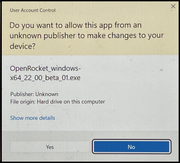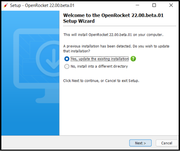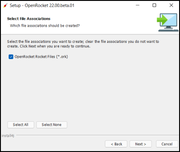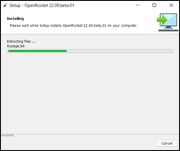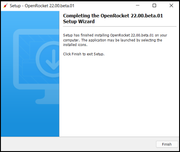Difference between revisions of "Linux OS"
Hcraigmiller (talk | contribs) (→Linux) |
JoePfeiffer (talk | contribs) |
||
| Line 1: | Line 1: | ||
=== <u>Linux</u> === | === <u>Linux</u> === | ||
| + | |||
| + | |||
| + | == 2022 Beta Release == | ||
| + | [https://github.com/openrocket/openrocket/releases/download/release-22.02.beta.01/OpenRocket_unix_22_02_beta_01.sh OpenRocket 22.02.beta.01 Installer for Linux <font color="red">(INACTIVE UNTIL RELEASE DATE)</font color>] | ||
| + | |||
| + | Download the Linux installer above for the <font color="red"><i>NEW</i></font color> OpenRocket beta release, saying yes to whatever security prompts your browser presents. Then, navigate to the directory in which you downloaded the installer, and make it executable like this: | ||
| + | % cd Downloads ''(or wherever you downloaded it to)'' | ||
| + | % chmod +x OpenRocket_unix_22_02_beta_01.sh | ||
| + | % ./OpenRocket_unix_22_02_beta_01.sh | ||
| + | |||
| + | |||
| + | <p>After the OpenRocket installer is downloaded, OpenRocket may be installed by doing the following:</p> | ||
| + | |||
| + | <table class="left" style="width:840px"> | ||
| + | <tr> | ||
| + | <th>What you see</th> | ||
| + | <th>What you do</th> | ||
| + | </tr> | ||
| + | <tr> | ||
| + | <td>'''[[File:Install_Windows_Prompt_01.png|left|frameless|180 px|center]]'''</td> | ||
| + | <td><p><b>Double-left-click on or open the installation file to run the installer</b> to start the <i>instal4j</i> installation wizard, displaying the progress of the file transfer.</p></td> | ||
| + | </tr> | ||
| + | <tr> | ||
| + | <td>'''[[File:Install_Windows_Prompt_02.png|left|frameless|180 px|center]]'''</td> | ||
| + | <td><p>After the file transfer is complete, a warning screen will appear asking for your permission to allow this application to make changes to your device. <u>To continue with the installation</u>, <b>left-click on the "Yes" button</b>.</p></td> | ||
| + | </tr> | ||
| + | <tr> | ||
| + | <td>'''[[File:Install_Windows_Prompt_03.png|left|frameless|180 px|center]]'''</td> | ||
| + | <td><p>The <i>Welcome</i> screen for the OpenRocket installation will then appear, giving you the option of choosing a different directory in which to save the OpenRocket files. <u>Unless you are familiar with directory structures</u>, you should <b>leave "Yes..." selected and left-click the "Next" button</b>.</p></td> | ||
| + | </tr> | ||
| + | <tr> | ||
| + | <td>'''[[File:Install_Windows_Prompt_04.png|left|frameless|180 px|center]]'''</td> | ||
| + | <td>The next step is to set the file extension associations. The "OpenRocket Rocket Files (*ork)" box should already be checked, so, <u>unless you want to change the file associations</u>, you can just <b>left-click the "Next" box</b>.</td> | ||
| + | </tr> | ||
| + | <tr> | ||
| + | <td>'''[[File:Install_Windows_Prompt_05.png|left|frameless|180 px|center]]'''</td> | ||
| + | <td>As the OpenRocket application is installed, the installation progress is displayed.</td> | ||
| + | </tr> | ||
| + | <tr> | ||
| + | <td>'''[[File:Install_Windows_Prompt_06.png|left|frameless|180 px|center]]'''</td> | ||
| + | <td>After the installation has finished, the final prompt appears, stating that OpenRocket can be launched by selecting the installed icons. <b>Left-click the "Finish" button</b> to return to the <i>Desktop</i></td> | ||
| + | </tr> | ||
| + | </table> | ||
| + | |||
| + | <p>* Screenshots may vary with the Windows operating system version installed on your device; the screenshots shown are from Windows 11.</p> | ||
| + | |||
| + | <b><u>''Special notice''</u></b>: At the present time, this installer does not create a shortcut on the desktop or the start menu. After installing, the executable file for the application (OpenRocket.exe) is located in the "C:\ProgramFiles\OpenRocket” folder. For easy access to OpenRocket in the future, you can open that folder in Windows Explorer, right click the "OpenRocket.exe" file (NOT the “OpenRocket.jar” file), and create a shortcut, pin it to the taskbar, and/or pin it to the start menu, as you wish. | ||
| + | |||
| + | == 2015 Version 15.03 == | ||
| + | |||
| + | [https://github.com/openrocket/openrocket/releases/download/release-15.03/OpenRocket-15.03-installer.exe OpenRocket 15.03 Installer for Windows] | ||
| + | |||
| + | <U>''Please note''</U>: This installer <b><i>does not</i></b> provide a shortcut on the desktop or the start menu. After installing, the actual executable file for the application is installed into your user/AppData/Local/OpenRocket folder. Open that folder in Windows Explorer, right click the "OpenRocket.exe" file (NOT the “OpenRocket.jar” file), and create a shortcut, pin it to the taskbar and/or pin it in the start menu, as you desire, for easy access to it in the future. | ||
Before beginning, you will need to have the FUSE filesystem installed; most distributions have it installed by default. Download the AppImage file for the version of OpenRocket that you want, and run it by double-clicking, or from the command line. | Before beginning, you will need to have the FUSE filesystem installed; most distributions have it installed by default. Download the AppImage file for the version of OpenRocket that you want, and run it by double-clicking, or from the command line. | ||
Revision as of 00:48, 24 February 2022
Linux
2022 Beta Release
OpenRocket 22.02.beta.01 Installer for Linux (INACTIVE UNTIL RELEASE DATE)
Download the Linux installer above for the NEW OpenRocket beta release, saying yes to whatever security prompts your browser presents. Then, navigate to the directory in which you downloaded the installer, and make it executable like this:
% cd Downloads (or wherever you downloaded it to) % chmod +x OpenRocket_unix_22_02_beta_01.sh % ./OpenRocket_unix_22_02_beta_01.sh
After the OpenRocket installer is downloaded, OpenRocket may be installed by doing the following:
| What you see | What you do |
|---|---|
Double-left-click on or open the installation file to run the installer to start the instal4j installation wizard, displaying the progress of the file transfer. |
|
After the file transfer is complete, a warning screen will appear asking for your permission to allow this application to make changes to your device. To continue with the installation, left-click on the "Yes" button. |
|
The Welcome screen for the OpenRocket installation will then appear, giving you the option of choosing a different directory in which to save the OpenRocket files. Unless you are familiar with directory structures, you should leave "Yes..." selected and left-click the "Next" button. |
|
| The next step is to set the file extension associations. The "OpenRocket Rocket Files (*ork)" box should already be checked, so, unless you want to change the file associations, you can just left-click the "Next" box. | |
| As the OpenRocket application is installed, the installation progress is displayed. | |
| After the installation has finished, the final prompt appears, stating that OpenRocket can be launched by selecting the installed icons. Left-click the "Finish" button to return to the Desktop |
* Screenshots may vary with the Windows operating system version installed on your device; the screenshots shown are from Windows 11.
Special notice: At the present time, this installer does not create a shortcut on the desktop or the start menu. After installing, the executable file for the application (OpenRocket.exe) is located in the "C:\ProgramFiles\OpenRocket” folder. For easy access to OpenRocket in the future, you can open that folder in Windows Explorer, right click the "OpenRocket.exe" file (NOT the “OpenRocket.jar” file), and create a shortcut, pin it to the taskbar, and/or pin it to the start menu, as you wish.
2015 Version 15.03
OpenRocket 15.03 Installer for Windows
Please note: This installer does not provide a shortcut on the desktop or the start menu. After installing, the actual executable file for the application is installed into your user/AppData/Local/OpenRocket folder. Open that folder in Windows Explorer, right click the "OpenRocket.exe" file (NOT the “OpenRocket.jar” file), and create a shortcut, pin it to the taskbar and/or pin it in the start menu, as you desire, for easy access to it in the future.
Before beginning, you will need to have the FUSE filesystem installed; most distributions have it installed by default. Download the AppImage file for the version of OpenRocket that you want, and run it by double-clicking, or from the command line.
OpenRocket 22.00.beta.01 AppImage for Linux (INACTIVE UNTIL RELEASE DATE)

